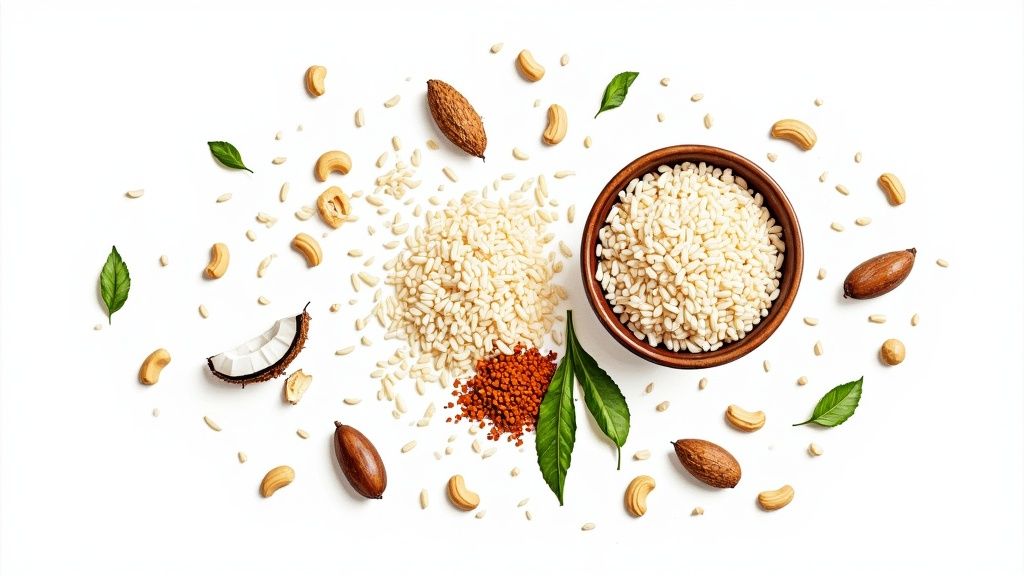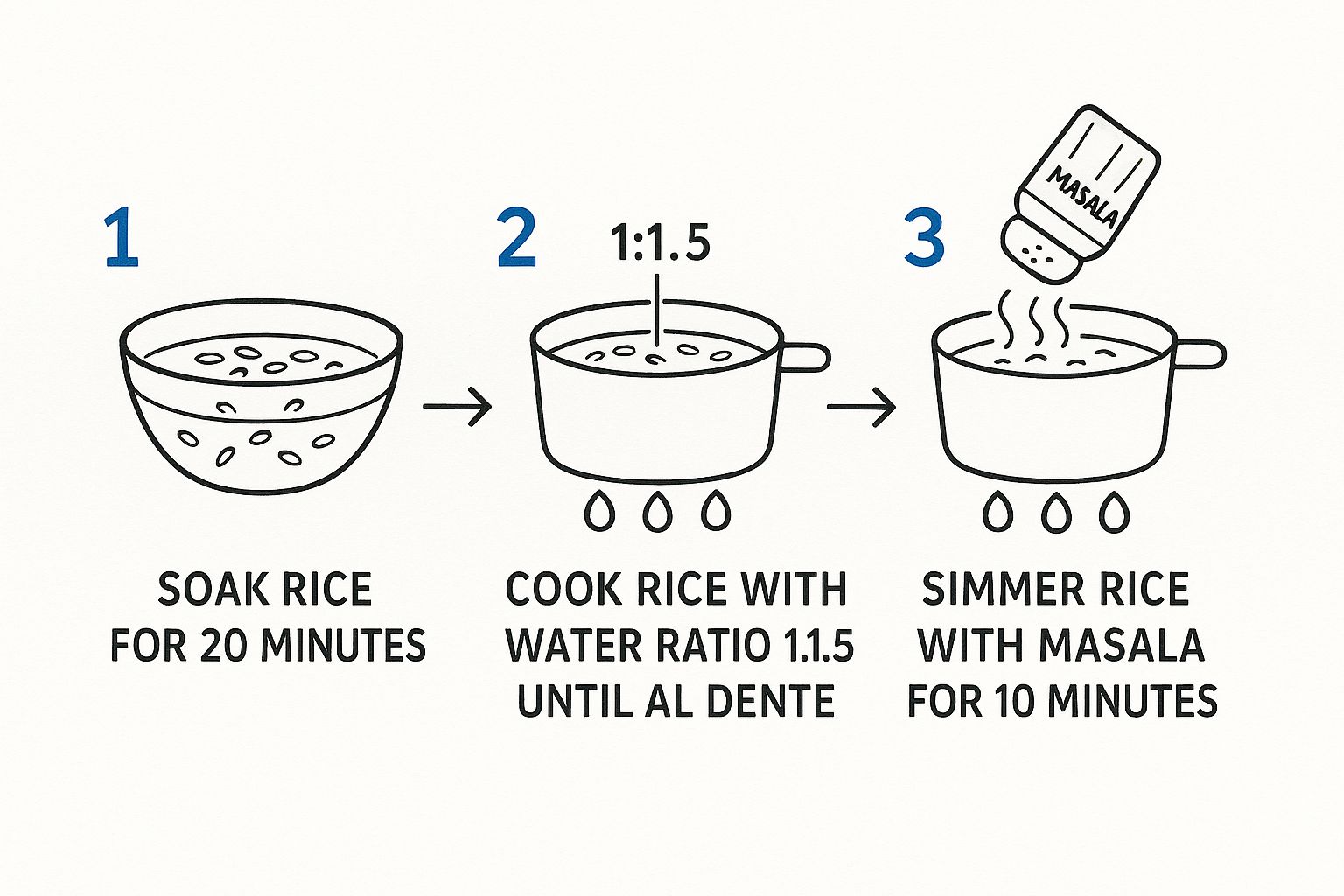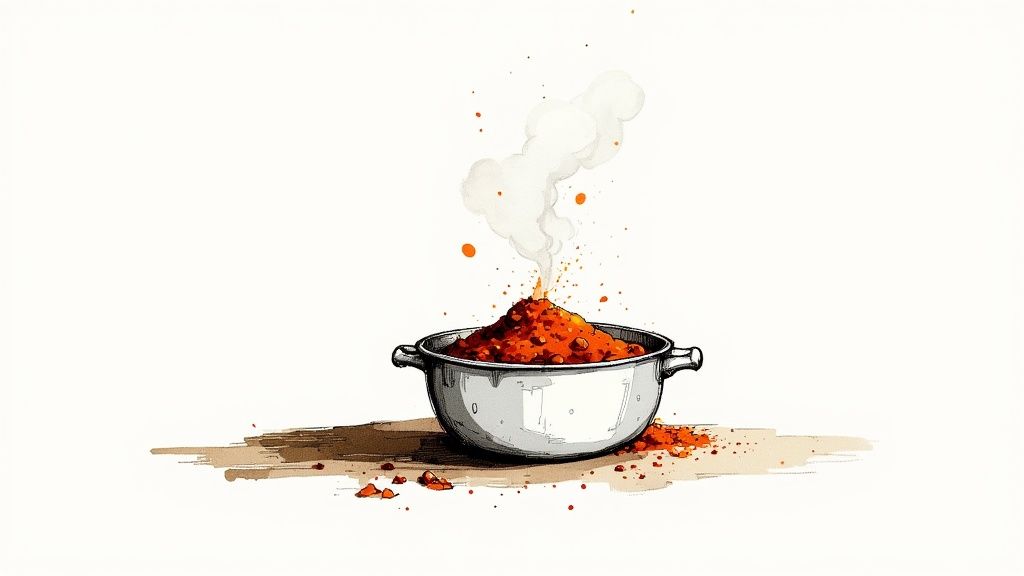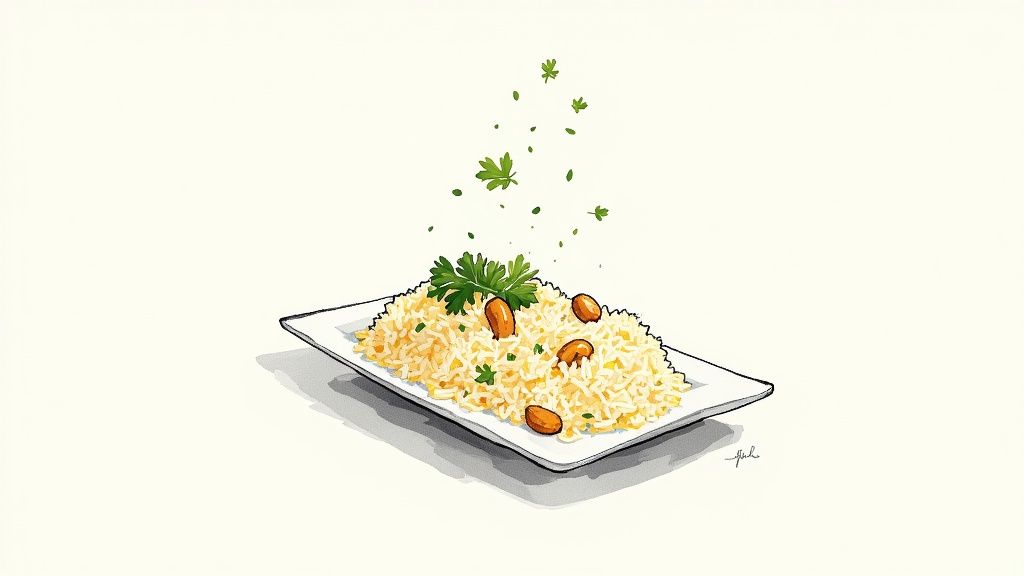The Perfect Recipe of Bagara Rice
Discover the perfect recipe of bagara rice with this simple guide. Create an authentic, fragrant Hyderabadi dish right in your own kitchen tonight.
Posted by
When you master a fantastic recipe of bagara rice, you're not just making a side dish; you're creating a fragrant, fluffy masterpiece. This Hyderabadi classic involves slow-cooking Basmati rice with whole spices, caramelized onions, and a touch of ghee, resulting in an aroma that fills the whole house. It's the perfect companion for rich curries but is honestly delicious enough to stand on its own.
What Makes Bagara Rice a Hyderabadi Classic?

If you've never tried Bagara Rice, you're in for a treat. Hailing from the heart of Hyderabadi cuisine, this dish is a true culinary experience. The name "Bagara" actually refers to the tempering process—that magical moment when whole spices hit hot ghee or oil. They sizzle, pop, and release their essential oils, creating a deeply aromatic foundation for the rice.
Unlike a more complex Biryani, Bagara Rice is celebrated for its elegant simplicity. It’s the kind of dish that feels special enough for a celebration but is easy enough to whip up for a comforting weeknight meal.
The magic really comes down to a few key elements working in perfect harmony:
- Aromatic Spices: Whole spices like cinnamon, cloves, and cardamom are the soul of the dish. No ground powders here.
- Golden Onions: Thinly sliced onions are fried until perfectly golden brown, which adds a subtle, almost-caramelized sweetness that’s irreplaceable.
- Quality Ghee: While you can use oil, traditional ghee (clarified butter) gives it a rich, nutty flavor that truly elevates the final result.
Bagara Rice Recipe at a Glance
Here’s a quick overview of what goes into this classic dish. Getting these components right is the key to achieving that authentic Hyderabadi flavor.
| Component | What You Need | Its Role in the Dish |
|---|---|---|
| Rice | Long-grain Basmati | Provides the fluffy, separate grains that are essential for the texture. |
| Fat | Ghee or Neutral Oil | Carries the flavor of the spices and helps toast the rice. |
| Aromatics | Whole Spices & Onions | The heart of the "Bagara"—creates the signature aroma and a hint of sweetness. |
| Liquid | Water or Broth | Cooks the rice and absorbs all the infused flavors from the tempering. |
| Herbs | Mint & Cilantro | Adds a fresh, bright finish that cuts through the richness. |
As you can see, the beauty is in its simplicity. It’s a testament to how a few quality ingredients, prepared with care, can create something truly memorable.
A Dish That Balances Flavor and Simplicity
The versatility of Bagara Rice is what makes it a staple. Rice-based dishes are beloved across the globe, and for good reason. It’s a fundamental source of energy. In fact, global rice consumption hit about 523.8 million metric tons in 2023/24, a huge jump from 437.18 million in 2008/09. As you can see from the global rice consumption trends on Statista.com, it's a critical food source for over 3.5 billion people.
Understanding how different foods fit into your day is part of mindful eating. It’s about being aware, not restrictive.
The best part is that enjoying incredible homemade food like this fits perfectly into a balanced lifestyle. You don't need to sacrifice flavor to stay mindful of your nutrition.
And tracking it doesn't have to be a chore. With an app like munchlog.ai, you can just say, "a bowl of homemade bagara rice," and the AI instantly figures out the nutritional breakdown. It’s all about enjoying your food without the stress.
What You'll Need for Authentic Bagara Rice
The secret to a truly exceptional bagara rice isn't some complicated technique; it's all about the quality of your ingredients. Think of this as the fun part—the beginning of a delicious project. Getting everything lined up and ready to go makes the actual cooking process a total breeze.
The Heart of the Dish: Basmati Rice
First things first, let's talk rice. For this dish, it has to be Basmati rice. Its long, elegant grains are non-negotiable because they cook up light and fluffy, with each grain staying separate. This is key, as it allows them to soak up all the incredible aromas from the spices without turning into a sticky mess.
Basmati isn't just another rice variety; it's a global superstar. Its unique fragrance and extra-long grains make it a prized export from northern India and Pakistan, with annual exports often topping 6 million metric tons. If you're curious, you can dive deeper into the cultural and economic importance of rice at Statista.com.
The Aromatic Foundation: Whole Spices
Next up, the whole spices. This is where the magic really happens. Using whole spices instead of ground powders is a game-changer because they slowly infuse their essential oils into the hot ghee, building layers of authentic flavor that you just can't get from a pre-made mix.
Here’s the classic quartet you'll need:
- Cinnamon Sticks: Just one or two small pieces will add a warm, sweet, and woody note that’s absolutely essential.
- Green Cardamom Pods: These little pods pack a complex, slightly sweet, and floral aroma. Give them a gentle crush right before you toss them in to wake them up.
- Cloves: A few of these bring a pungent, intense, and slightly sweet flavor. Be careful, a little goes a very long way!
- Bay Leaves: Don't skip these! They add a subtle, almost minty background note that beautifully ties all the other spices together.
The Flavor Builders: Onions, Ginger, Garlic, and Ghee
Finally, we have the ingredients that create the rich, savory base of the dish.
You'll need thinly sliced onions, which we'll fry to a perfect golden brown to unlock their deep, caramelized sweetness. A simple paste of fresh ginger and garlic brings a sharp, pungent kick that cuts through the richness and balances everything out.
And of course, we need a cooking fat. The traditional choice here is ghee (clarified butter). Its nutty, rich flavor is something that plain oil just can't replicate, and it gives the rice its signature taste.
A Quick Tip for Tracking: Knowing exactly what’s in your food makes logging it so much easier. With an app like munchlog.ai, you can just say, "homemade bagara rice with basmati and ghee," and the AI gets it. It understands the core ingredients and gives you an accurate nutritional picture without any fuss.
Cooking Fluffy and Fragrant Bagara Rice
Alright, this is where the magic happens. Let's get this Bagara Rice on the stove! Don't let the name fool you; this recipe is all about simple techniques executed well. We'll go through it step-by-step to make sure you nail that perfectly fluffy, aromatic rice every single time.

As you can see, it really boils down to three key stages: soaking, cooking, and simmering. Getting this rhythm right is the secret to a final dish where every grain is separate and beautifully cooked.
Preparing the Rice and Aromatics
First things first: the rice. You absolutely have to rinse your Basmati rice. I can't stress this enough. Just run it under cold water until the water is no longer cloudy. This simple action washes away the excess surface starch—the number one reason for gummy, clumpy rice.
Once it's rinsed, let the rice soak in a bowl of fresh water for about 20-30 minutes. A little patience here goes a long way. Soaking allows the grains to hydrate from the inside out, which helps them cook evenly and grow long and elegant instead of breaking apart in the pot.
While the rice is having its bath, get your other ingredients ready. Thinly slice the onions, measure out your ginger-garlic paste, and gather your whole spices. Trust me, having everything prepped and ready to go makes the actual cooking process feel effortless and fun.
Tempering Spices and Building Flavor
With your rice soaked and drained, it's time to build those incredible layers of flavor.
Grab a heavy-bottomed pot and melt the ghee over medium heat. Once it's shimmering, toss in your whole spices—the cinnamon stick, cardamom pods, cloves, and bay leaf. You’ll only need to let them sizzle for about 30 seconds. You'll know they're ready when your kitchen starts to smell amazing. This technique is called "tempering" or "bagara," and it's how we infuse the ghee with all those wonderful aromatic oils.
Next, add your sliced onions. Sauté them until they're a deep golden brown. This isn't a quick step; it can take a good 10-15 minutes, but it’s worth it. Don't rush this part! That caramelization builds a subtle sweetness that is the heart and soul of this dish. When the onions look perfect, stir in the ginger-garlic paste and cook for another minute to get rid of that raw scent.
This is the moment your kitchen transforms. The aroma of toasting spices mingling with sweet, browning onions is the signature scent of a true Hyderabadi kitchen. It’s one of the best parts of making this dish from scratch.
Finally, gently add the drained rice to the pot. Stir it carefully for a minute or so, making sure every grain gets coated in that fragrant, spiced ghee. This little step helps prevent sticking.
Now, pour in the water. For perfect Basmati, the golden ratio is 1.5 cups of water for every 1 cup of rice. Add your salt, give it one last gentle stir, and bring the water to a rolling boil.
As soon as it boils, immediately reduce the heat to the lowest setting, cover the pot with a tight-fitting lid, and let it simmer for 10-12 minutes. No peeking! Once the time is up, turn off the heat but leave the lid on. Let the rice rest for another 5 minutes to finish steaming. Then, and only then, you can open it up and fluff the grains with a fork. Perfection.
Pro Tips to Elevate Your Bagara Rice

Once you’ve got the basic Bagara Rice recipe down, the real fun begins. A few simple tweaks here and there can take your dish from just "good" to something truly special, adding layers of flavor, texture, and color that will have everyone asking for your secret.
For an extra touch of luxury, soak a tiny pinch of saffron in warm milk. Drizzle it over the rice right before the final steam—it infuses the grains with a gorgeous golden color and an incredible aroma. If you're after a bit of crunch, try frying a handful of cashews or slivered almonds in ghee until they're golden brown and scattered on top just before serving. It's a game-changer.
Avoiding Common Mistakes
Even seasoned cooks can have an off day. The most common issue with Bagara Rice? Burning the whole spices. It happens.
To get it right, make sure your ghee is hot but not smoking when you add them. You're looking for a sizzle, not a scorch. The spices only need about 30 seconds to bloom and release their fragrance. Any longer, and you risk a bitter, burnt taste that can ruin the whole dish.
The other big one is mushy rice. If yours is coming out a bit sticky, the culprit is usually too much water or not rinsing the rice well enough. That pre-soak is critical. Stick to a strict 1:1.5 rice-to-water ratio, and you'll get perfectly separate, fluffy grains every single time.
A Quick Tip on Leftovers: Don't just toss leftover Bagara Rice in the microwave. To bring it back to life, store it in an airtight container in the fridge (it keeps for up to three days). When you're ready to reheat, sprinkle a little water over the top and then microwave. The steam helps restore that fresh, fluffy texture.
Small Additions, Big Nutritional Impact
Little additions don't just add flavor; they can also shift the nutritional profile of your meal. Tossing in those cashews, for instance, adds healthy fats and a welcome boost of protein.
Bagara rice is a classic Hyderabadi celebratory dish, beloved for its incredible blend of spices, nuts, and ghee cooked with long-grain Basmati. It creates this wonderful, aromatic side that's both nutty and buttery. If you're interested in the history and role of rice in different cuisines, the USDA has some great insights on its cultural significance.
Keeping track of these little changes is super easy with an app like munchlog.ai. You can just say, "homemade bagara rice with cashews," and it'll instantly update the macros for you. It's a great way to stay mindful of your nutrition while still experimenting in the kitchen and enjoying every bite.
Finding the Perfect Partner for Your Bagara Rice
Bagara Rice is wonderful all by itself, but it truly comes alive when you pair it with the right side dish. Think of it as the perfect, fragrant foundation for all kinds of rich, flavorful curries and stews.
The magic of this rice is in its subtle, aromatic flavor. It’s designed to complement bold dishes, not compete with them, which is why it’s such a versatile player at the dinner table.
Classic and Creative Pairings
For a truly authentic Hyderabadi meal, you can't go wrong with classic pairings like Bagara Baingan (a fantastic eggplant curry) or a hearty Dalcha (a stew made with lentils and meat). The rice just soaks up those incredible gravies.
But don't stop there! This rice is a team player and works beautifully with so many other dishes.
- Creamy Curries: It's practically made for a decadent chicken korma or your go-to paneer masala. The rice cuts through the richness and balances every bite.
- Grilled Meats and Kebabs: Serve a generous spoonful next to grilled chicken or succulent kebabs. The carbs in the rice provide sustained energy—and if you're curious, you can learn more about how boiled chicken offers a healthy protein source right here.
- A Lighter Touch: For something quick and refreshing, a simple bowl of Bagara Rice with a side of cooling raita (yogurt dip) and a crisp salad is a perfectly balanced meal.
The real secret is building a plate of food you genuinely love. Pairing foods that bring you joy is the cornerstone of a healthy, sustainable relationship with eating. It makes the entire experience so much more satisfying.
And when you're done enjoying your creation, logging it is a breeze. Just tell the munchlog.ai app, "I had bagara rice with chicken korma," and it handles the rest. You get to savor a perfectly paired meal without the headache of manual tracking.
How This Bagara Rice Fits Your Nutrition Goals

So, you've made this incredible recipe of bagara rice, but you might be wondering how it fits into your day. The good news is, enjoying delicious, traditional food and staying mindful of your nutrition aren't mutually exclusive. It's all about awareness, not deprivation.
This dish is a fantastic source of carbohydrates from the Basmati rice, giving you that essential, sustained energy. The ghee adds healthy fats, making it a truly satisfying and comforting component of any meal. Of course, the exact numbers will shift based on your specific ingredients and how big of a scoop you take!
To give you a clearer picture, I've put together a rough nutritional estimate. Keep in mind this is an approximation and can vary.
Estimated Nutrition Per Serving
This table breaks down the approximate nutritional value for a single serving of our Bagara Rice.
| Nutrient | Approximate Amount | Why It Matters |
|---|---|---|
| Calories | 250-350 kcal | Provides the energy your body needs to function. |
| Carbs | 45-55g | Your body's primary fuel source, especially for brain function. |
| Protein | 4-6g | Essential for muscle repair and a feeling of fullness. |
| Fat | 5-8g | Important for hormone production and nutrient absorption. |
This breakdown shows that Bagara Rice is a solid, energy-giving dish, perfect for pairing with a lean protein like grilled chicken or a vegetable curry to create a complete, balanced meal.
Forget Tedious Tracking
The real challenge isn't the food itself, but the hassle of logging it. Nobody wants to spend their time weighing every grain of rice or manually inputting long ingredient lists. That's where smart, modern tracking really shines.
Let's say you just finished a delicious dinner of your homemade Bagara Rice with some chicken curry on the side. Instead of pulling out a calculator, you could simply speak.
Just say, "I had homemade bagara rice and chicken curry for dinner," and let the AI handle the rest. This is a game-changer because it takes the tedious work out of the equation, so you can focus on enjoying your food.
This approach proves you don't have to give up your favorite cultural dishes to be mindful of your nutrition. If you're tired of the old way of doing things, you should see how an easy food tracking app can make all the difference. It's about being aware, not obsessive.
By logging your meal in seconds, you get an intelligent estimate of your macros without the headache. It makes nutrition a seamless, natural part of your day, not a chore to be dreaded.
Answering Your Questions About Bagara Rice
Before you head into the kitchen, it's totally normal to have a few questions. Getting these details sorted out first is the key to making sure your Bagara Rice turns out perfectly, especially on your first attempt. Let's walk through some of the most common queries I get.
Can I Use a Different Type of Rice?
This is a great question. While Basmati rice is the classic choice for its incredible aroma and the way the grains cook up so fluffy and separate, you do have options. If you don't have Basmati on hand, another long-grain white rice like Jasmine can work in a pinch.
Keep in mind that you might need to tweak the amount of water. Different rice varieties absorb liquid differently, so be prepared to adjust. I'd strongly suggest steering clear of short-grain rice, as its higher starch content will result in a sticky texture, which isn't what we're going for here.
How Do I Make This Recipe Vegan?
Easy! To make a fantastic vegan Bagara Rice, just swap out the ghee. A high-quality, neutral-flavored oil is your best bet—think avocado oil or even a good coconut oil. A high-quality vegan butter would also do the trick beautifully.
Everything else in the recipe, from the fragrant whole spices to the onions and rice, is already plant-based. You'll lose a little of that nutty flavor ghee provides, but the dish will still be absolutely delicious and aromatic.
Remember, simple swaps like this are easy to log. Just say, "I had vegan bagara rice made with coconut oil," and munchlog.ai will adjust the nutritional info for you. It's all about making tracking fit your lifestyle, not the other way around.
What Should I Serve with Bagara Rice?
Bagara Rice is one of those dishes that plays well with almost anything. It’s traditionally served alongside rich Hyderabadi curries like Bagara Baingan (a fantastic eggplant curry) or a hearty Dalcha.
It's also the perfect sidekick for creamy chicken or mutton curries and paneer dishes. For a lighter meal, you really can't go wrong serving it with a simple bowl of cooling raita and a fresh salad. The rice is flavorful enough to shine but subtle enough not to overpower the main course.
Ready to enjoy delicious meals like this without the stress of manual food logging? With munchlog.ai, just say what you ate, and the AI does the rest. Give it a try today and see how effortless mindful eating can be.